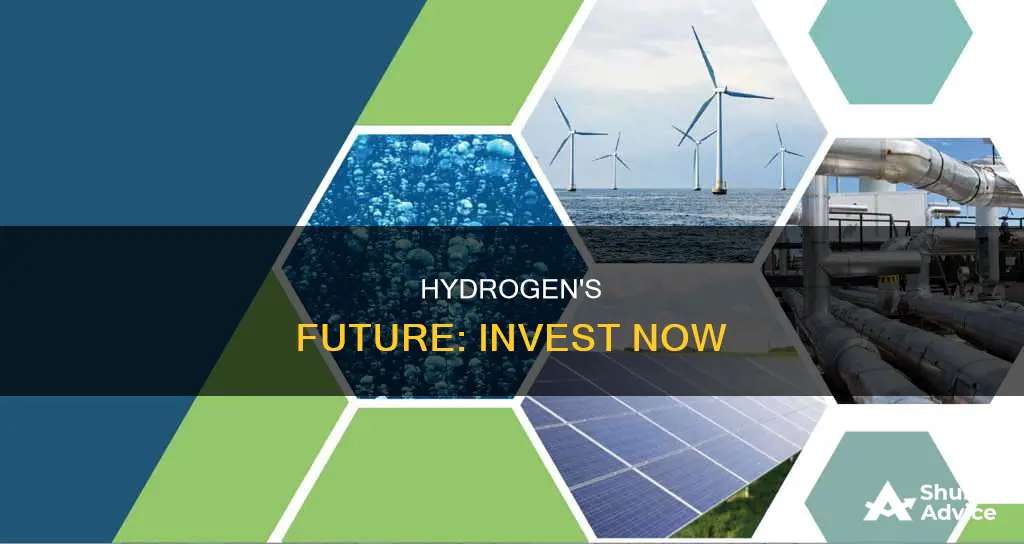
Hydrogen is a versatile, clean-burning element that can play a significant role in the transition to clean energy. It has a wide range of applications, from powering vehicles to industrial processes, and can help reduce emissions from fossil fuels and heavily polluting industries. However, there are challenges to its widespread adoption, including storage and transportation difficulties, as well as the high cost of production. Despite these hurdles, hydrogen has gained political support, with governments recognising its potential in the clean energy transition.
Hydrogen is an attractive investment opportunity due to its versatility and ability to reduce carbon emissions. It can be used in various industries, including transportation, chemicals, steel, and power generation. The demand for hydrogen is expected to increase significantly in the coming decades, creating numerous investment opportunities.
One of the key challenges to hydrogen adoption is its production process. Currently, most hydrogen is produced from natural gas or coal, resulting in carbon emissions. However, advancements in technology have led to the development of green hydrogen, which is produced using renewable energy sources without any carbon emissions. This makes it an attractive alternative to traditional fossil fuels.
In conclusion, investing in hydrogen offers a promising opportunity to support the transition to clean energy and capitalise on the growing demand for sustainable solutions. With the right innovations and policies in place, hydrogen has the potential to become a major player in the global energy landscape.
| Characteristics | Values |
|---|---|
| Clean energy source | Hydrogen is a clean-burning element that emits no greenhouse gases when burned. |
| Carbon reduction | Hydrogen can help reduce emissions from fossil fuels and heavily polluting industries. |
| Energy versatility | Hydrogen can be produced from almost all energy resources, including renewable sources such as wind, solar, and hydropower. |
| Energy storage | Hydrogen can be used to store energy, functioning as a battery to complement renewable energy sources. |
| Energy transmission | Hydrogen can be transported as a gas by pipelines or in liquid form by ships. |
| Energy efficiency | Hydrogen has a high energy density, meaning it can store a greater amount of energy in its mass. |
| Fuel for transport | Hydrogen can be used to power vehicles, including cars, trucks, trains, ships, and airplanes. |
| Fuel for industry | Hydrogen can be used in industrial processes such as chemical and industrial production, oil refining, and steel production. |
| Fuel for buildings | Hydrogen could be used for heating buildings, although there are already cleaner and cheaper alternatives such as heat pumps. |
| Fuel infrastructure | Hydrogen can utilise existing fossil fuel infrastructure, such as pipelines and storage facilities, with some modifications. |
| Fuel costs | Hydrogen is currently costly to produce, but costs are expected to decrease with technological advancements and increased production scale. |
| Fuel safety | Hydrogen is highly flammable and corrosive, requiring specialised infrastructure to ensure safe transmission and storage. |
| Fuel availability | Hydrogen is rarely found in an easily extractable form and is not yet produced at the scale needed for economic competitiveness. |
What You'll Learn
- Hydrogen is versatile and can be used for power generation, transport, and industry
- Hydrogen can help reduce emissions from fossil fuels and heavily polluting industries
- Hydrogen can improve the reliability of renewable energy
- Hydrogen can be used to replace natural gas in the pipeline system
- Hydrogen is scalable and can be produced from a variety of sources

Hydrogen is versatile and can be used for power generation, transport, and industry
Hydrogen is a versatile energy carrier, which can be used for power generation, transport, and industry.
Hydrogen can be used to generate electricity in multiple ways. Hydrogen fuel cells, for example, produce electricity by combining hydrogen and oxygen atoms in an electrochemical reaction similar to that of a battery. Hydrogen can also be burned to generate electricity and heat, although this method is not yet widely used. Hydrogen is also one of the leading options for storing renewable energy, and it can be used in gas turbines to increase power system flexibility.
In the transport sector, hydrogen can be used as an alternative vehicle fuel for cars, trucks, ships, planes, and even space shuttles. Hydrogen-powered vehicles are zero-emission, improve air quality, and promote energy security. Hydrogen fuel cells for vehicles are more efficient than internal combustion engines, although the high cost of fuel cells and the limited availability of hydrogen fuelling stations have hindered their widespread adoption.
Hydrogen is also widely used in industry, particularly in oil refining, ammonia production, methanol production, and steel production. Hydrogen can be used to lower the sulfur content of fuels and produce renewable diesel. Additionally, hydrogen can be combined with carbon from CO2 to produce hydrocarbons and virtually any molecule, such as ammonia, methanol, synthetic fuels, and iron. Hydrogen can also be used in place of coal in iron production.
Renewables: Why the Reluctance?
You may want to see also

Hydrogen can help reduce emissions from fossil fuels and heavily polluting industries
Hydrogen can play a significant role in reducing emissions from fossil fuels and heavily polluting industries. It is a versatile energy carrier that can help tackle critical energy challenges. Hydrogen can be used to decarbonize sectors where emissions are hard to abate, such as long-haul transport, chemicals, iron and steel production, and heavy industry.
Currently, hydrogen is mainly used in the refining and chemical sectors, produced using fossil fuels like coal and natural gas, contributing to significant annual CO2 emissions. However, clean hydrogen produced with renewable or nuclear energy, or fossil fuels with carbon capture technology, can help reduce these emissions. Hydrogen-powered vehicles, for example, would improve air quality and promote energy security.
The demand for pure hydrogen is expected to increase significantly in the coming decades as industries seek to reduce their carbon footprint. Hydrogen can also support the integration of variable renewables in the electricity system by storing energy over extended periods. Additionally, hydrogen can be transported and used for power generation in buildings, either directly or by blending into existing natural gas networks.
To realize the potential of hydrogen in reducing emissions, several challenges need to be addressed. These include the high cost of producing hydrogen from low-carbon sources, the slow development of hydrogen infrastructure, and the need for regulatory changes to support the adoption of clean hydrogen. However, with growing momentum and increasing investment in hydrogen technologies, there is an opportunity to scale up hydrogen production and make it a key component of the transition to clean energy.
Backpack Wheels: Invest in Comfort
You may want to see also

Hydrogen can improve the reliability of renewable energy
Hydrogen has the potential to improve the reliability of renewable energy. It is one of the leading options for storing renewable energy, and it can be used to improve the variable output from renewables like solar photovoltaics (PV) and wind, whose availability is not always well-matched with demand. Hydrogen can be stored for days, weeks, or even months, making it a promising option for storing electricity over extended periods. This capability is particularly valuable for transporting energy from renewables-rich regions to energy-hungry cities located thousands of kilometres away.
Additionally, hydrogen can support the integration of variable renewables in the electricity system. It can be transformed into electricity to power homes and industries and can be used as fuel for cars, trucks, ships, and planes. Hydrogen-powered vehicles also improve air quality and promote energy security.
The versatility of hydrogen is further highlighted by its ability to be transported as a gas through pipelines or in liquid form via ships, similar to liquefied natural gas (LNG). Hydrogen can be blended into existing natural gas networks, especially in multifamily and commercial buildings in dense cities.
However, hydrogen production and infrastructure development face challenges. Currently, hydrogen production is mostly supplied from natural gas and coal, resulting in significant CO2 emissions. Producing hydrogen from low-carbon energy sources is costly, and the development of hydrogen infrastructure, including refuelling stations and pipelines, is slow. Nevertheless, with declining costs for renewable electricity and advancements in electrolysers, hydrogen has the potential to play a pivotal role in improving the reliability of renewable energy.
Songs: The New Investment Avenue
You may want to see also

Hydrogen can be used to replace natural gas in the pipeline system
Hydrogen can be transported through pipelines in a similar way to natural gas. In fact, there are already around 1,600 miles of hydrogen pipelines in operation in the US. However, the majority of these pipelines are owned by merchant hydrogen producers and are located near large hydrogen users, such as petroleum refineries and chemical plants.
While it is possible to transport hydrogen through existing natural gas pipelines, there are some technical challenges to be aware of. Hydrogen is a much smaller molecule than methane, the main component of natural gas, and can squeeze into tiny spaces in certain steel alloys, causing "embrittlement" and making the metal more likely to crack or corrode. Hydrogen is also more likely to leak from valves, seals, and other connection points, and it is transported at a higher pressure than natural gas, which puts more stress on the pipeline.
One way to address these issues is to blend a small percentage of hydrogen with natural gas. Studies have found that blending up to 5% hydrogen with natural gas appears to be safe, while higher percentages may lead to embrittlement and an increased risk of leaks. However, blending hydrogen with natural gas does not significantly reduce greenhouse gas emissions from burning natural gas.
Another option is to convert existing natural gas pipelines to carry pure hydrogen. This would require more substantial modifications to the pipelines but could be a more economical and environmentally friendly solution in the long run. Germany, for example, is already testing the parameters for safe operation of an integrated hydrogen grid, and several natural gas pipelines in the country are being converted to hydrogen operation as part of the GET H2 Nucleus project.
The high initial capital costs of constructing new pipelines or converting existing ones are a major barrier to expanding hydrogen pipeline infrastructure. However, with the right policies and innovations, hydrogen has the potential to play a significant role in the transition to clean energy.
Apple: A Popular Investment Choice
You may want to see also

Hydrogen is scalable and can be produced from a variety of sources
Hydrogen is a versatile energy carrier that can be produced from a variety of sources, making it scalable. It can be separated from a range of sources, including water, fossil fuels, biomass, and renewable power sources like solar and wind.
The most common methods of hydrogen production today are natural gas reforming and electrolysis. Natural gas reforming is a thermal process that uses steam reforming to produce hydrogen. This involves a chemical reaction between steam and methane, the main component of natural gas. However, this process emits a significant amount of carbon dioxide, contributing to greenhouse gas emissions.
Electrolysis, on the other hand, is a process where water is separated into oxygen and hydrogen through a method called electrolysis, which takes place in an electrolyzer. This process can be powered by renewable energy sources like solar and wind power, resulting in the production of green hydrogen. Green hydrogen is considered a more sustainable option compared to grey hydrogen, which is produced from fossil fuels.
Other methods of hydrogen production include solar-driven processes, biological processes, and methane pyrolysis. Solar-driven processes use light as the agent for hydrogen production, while biological processes use microbes such as bacteria and microalgae to produce hydrogen through biological reactions. Methane pyrolysis is a newer process that does not produce greenhouse gas emissions, making it an attractive alternative to traditional steam methane reforming.
The scalability and variety of production methods for hydrogen highlight its potential as a clean energy source. By leveraging different sources and technologies, hydrogen can be produced more sustainably and efficiently, contributing to the transition towards clean energy.
Bonds: A Safe Haven for Investors
You may want to see also







